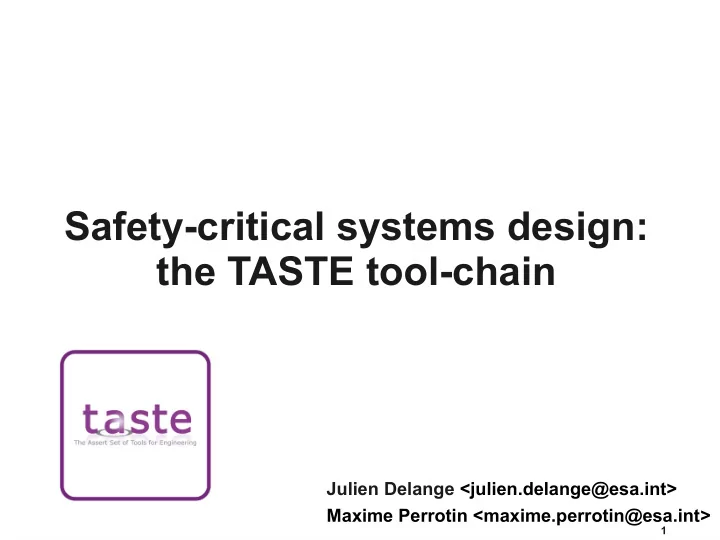

Safety-critical systems design: the TASTE tool-chain Julien Delange <julien.delange@esa.int> Maxime Perrotin <maxime.perrotin@esa.int> 1
High-integrity software constraints ● Real-Time determinism ● Safety & security ● Memory & processing constraints 2
Usual development process: myth 1.Specifications by designers 2.Validation by engineer 3.Development by voodoo coders 4.Tests, verification by engineers 5.Release by business consultants/sales dept. 3
Usual development process, overview Design Validation Validated Specifications specifications Program (binary) Implementation Verification, qualification 4
Usual development process, reality (1) 5
Usual development process, reality (2) 6
Funny but ... ● Nor for life-/mission- critical systems ● Must do the dirty and boring work ● And do it correctly 7
In addition ... ● Requirements and constraints increase Number of functions and their impacts ● Costs (money, time) ● ● Allocated resources decrease Budget ● Time, release to market ● ● Cannot use traditional methods 8
Key points ● Validation ● Automation ● Verification 9
Ideal development process 1.Specifications by designers 2.Validation by engineer analysis tools 3.Development by voodoo coders code generators 4.Tests/verif by engineers execution analysis tools 5.Release by business consultants/sales dept. 10
TASTE guidelines ● Abstract software & hardware ● Focus on engineering concerns ● Validate & verify as early as possible ● Automate as much as possible 11
TASTE process 1.Define system interfaces 2.Abstract soft & hard aspects 3.Validate & verify requirements 4.Generate application using ACG 12
TASTE development process Design Validation Validated Specifications specifications Program (binary) Implementation Verification, qualification 13
TASTE benefits Design Validation Specifications Validated specifications Design Specifications Vali Validated specifications dat ion Program (binary) Program (binary) Implementation Verification & qualification Implementation Verification & qualification Traditional process TASTE process 14
TASTE workflow Validation Specifications Scheduling ● Interfaces specifications ● Trade-off analysis ● Software models ● ... ● Deployment models ● Verification & Automatic Code Qualification Generation System execution ● Documentation generation ● Run-time analysis ● Software metrics acquisition ● 15
TASTE technologies (1) 1.System interfaces: ASN.1 2.Soft specifications: C/Ada, Simulink, SDL 3.Hard deployment & conf : AADL 16
TASTE technologies (2) Specifications Cheddar ASN1 Compilers COUVERTURE ● ● ● MAST Ocarina Qemu ● ● ● Ocarina/REAL Matlab/Simulink Gprof ● ● ● ... GNUplot ● ● Automatic Code Verification Validation Generation 17
TASTE use-case ARM movement acquisition Data transmission through PCI TASTE system Data acquisition from devices ● Heterogeneous software ● (Simulink, RTDS, bare-C) ARM movement reproduction Data transmission through ethernet 18
Demonstration 1.Interfaces and functions specifications 2.System validation 3.Automatic implementation 4.Verification 19
Conclusion ✔ OSS tool-chain for safety-critical systems ✔ Support by industry & academia ✔ Evaluation with real developments 20
Perspectives ➔ Enrich validation aspects ➔ Design OSS application code generators ➔ Improve verification tools 21
http://www.assert-project.net/taste 22
Recommend
More recommend